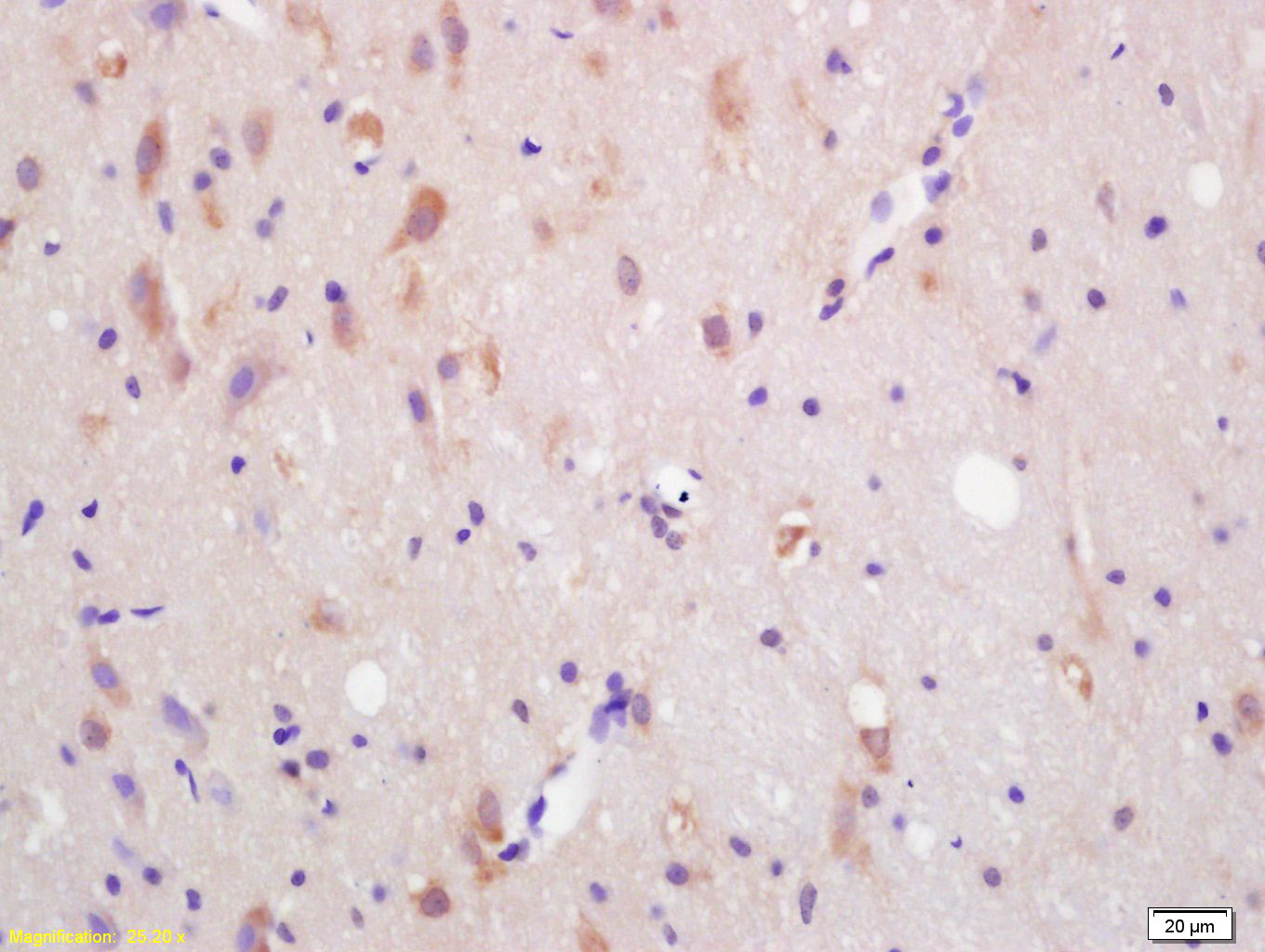
Rabbit Anti-ACKR3 antibody
GPCR RDC1; C X C chemokine receptor type 7; Chemokine C X C motif receptor 7; Chemokine orphan receptor 1; CMKOR1; CXC R7; CXCR 7; CXCR7; G protein coupled receptor 159; G protein coupled receptor RDC1 homolog; GPR159; RDC 1; RDC1; CXCR7_HUMAN.
View History [Clear]
Details
Product Name ACKR3 Chinese Name 细胞表面Chemokine受体7抗体 Alias GPCR RDC1; C X C chemokine receptor type 7; Chemokine C X C motif receptor 7; Chemokine orphan receptor 1; CMKOR1; CXC R7; CXCR 7; CXCR7; G protein coupled receptor 159; G protein coupled receptor RDC1 homolog; GPR159; RDC 1; RDC1; CXCR7_HUMAN. literatures Research Area vascular endothelial cell b-lymphocyte endothelial cells Immunogen Species Rabbit Clonality Polyclonal React Species Human, Rat, (predicted: Mouse, Dog, Pig, Cow, Horse, Rabbit, ) Applications ELISA=1:5000-10000 IHC-P=1:100-500 IHC-F=1:100-500 IF=1:100-500 (Paraffin sections need antigen repair)
not yet tested in other applications.
optimal dilutions/concentrations should be determined by the end user.Theoretical molecular weight 40kDa Cellular localization cytoplasmic The cell membrane Extracellular matrix Form Liquid Concentration 1mg/ml immunogen KLH conjugated synthetic peptide derived from human CXCR7: 151-250/362 <Extracellular> Lsotype IgG Purification affinity purified by Protein A Buffer Solution 0.01M TBS(pH7.4) with 1% BSA, 0.03% Proclin300 and 50% Glycerol. Storage Shipped at 4℃. Store at -20 °C for one year. Avoid repeated freeze/thaw cycles. Attention This product as supplied is intended for research use only, not for use in human, therapeutic or diagnostic applications. PubMed PubMed Product Detail This gene encodes a member of the G-protein coupled receptor family. Although this protein was earlier thought to be a receptor for vasoactive intestinal peptide (VIP), it is now considered to be an orphan receptor, in that its endogenous ligand has not been identified. The protein is also a coreceptor for human immunodeficiency viruses (HIV). Translocations involving this gene and HMGA2 on chromosome 12 have been observed in lipomas. GCPR RDC1 is reported to be expressed in human cell lines and in cultured vascular endothelial cells and in rodent brain, kidney, lung, heart, spleen, pancreas, small intestine, blood, colon, and blood vessels. ESTs have been isolated from human normal bone marrow, brain, breast, cartilage, embryo, eye, fetal lung/testis/B-cell, heart, heart/melanocyte/uterus, kidney, liver/spleen, nerve, placenta, and umbilical libraries as well as several human cancer libraries.
Function:
Receptor for chemokines CXCL12/SDF1 and CXCL11. Does not elicit classical chemokine receptor signaling; chemokine binding does not activate G-protein-mediated signal transduction but instead induces beta-arrestin recruitment, leading to ligand internalization and activation of MAPK signaling pathway. Acts as a scavenger for CXCL12/SDF1 and, to a lesser extent, for CXCL11. Required for regulation of CXCR4 protein levels in migrating interneurons, thereby adapting their chemokine responsiveness. In glioma cells, transduces signals via MEK/ERK pathway, mediating resistance to apoptosis. Promotes cell growth and survival. Not involved in cell migration, adhesion or proliferation of normal haematopoietic progenitors but activated by CXCL11 in malignant hemapoietic cells, leading to phosphorylation of ERK1/2 (MAPK3/MAPK1) and enhanced cell adhesion and migration. Plays a regulatory role in CXCR4-mediated activation of cell surface integrins by CXCL12. Required for heart valve development. Acts as coreceptor with CXCR4 for a restricted number of HIV isolates.
Subunit:
Homodimer. Can form heterodimers with CXCR4; heterodimerization may regulate CXCR4 signaling activity.
Subcellular Location:
Cell membrane; Multi-pass membrane protein. Cytoplasm, perinuclear region. Early endosome. Recycling endosome. Note=Localized mainly in perinuclear regions in neurons and in early endosomes in T-lymphocytes and some other cell types, with very low levels detected on the cell surface. May spontaneously cycle between the plasma membrane and endosomal compartments.
Tissue Specificity:
Expressed in monocytes, basophils, B-cells, umbilical vein endothelial cells (HUVEC) and B-lymphoblastoid cells. Lower expression detected in CD4+ T-lymphocytes and natural killer cells. In the brain, detected in endothelial cells and capillaries, and in mature neurons of the frontal cortex and hippocampus. Expressed in tubular formation in the kidney. Highly expressed in astroglial tumor endothelial, microglial and glioma cells. Expressed at low levels in normal CD34+ progenitor cells, but at very high levels in several myeloid malignant cell lines. Expressed in breast carcinomas but not in normal breast tissue (at protein level).
Similarity:
Belongs to the G-protein coupled receptor 1 family.
SWISS:
P25106
Gene ID:
57007
Database links:Entrez Gene: 57007 Human
Entrez Gene: 12778 Mouse
Omim: 610376 Human
SwissProt: P25106 Human
SwissProt: P56485 Mouse
Unigene: 471751 Human
Unigene: 6522 Mouse
Unigene: 12959 Rat
Product Picture
Antigen retrieval: citrate buffer ( 0.01M, pH 6.0 ), Boiling bathing for 15min; Block endogenous peroxidase by 3% Hydrogen peroxide for 30min; Blocking buffer (normal goat serum,C-0005) at 37℃ for 20 min;
Incubation: Anti-CXCR7/RDC1 Polyclonal Antibody, Unconjugated(SL4897R) 1:200, overnight at 4°C, followed by conjugation to the secondary antibody(SP-0023) and DAB(C-0010) staining
References (0)
No References
Bought notes(bought amounts latest0)
No one bought this product
User Comment(Total0User Comment Num)
- No comment



 +86 571 56623320
+86 571 56623320
 +86 18668110335
+86 18668110335

